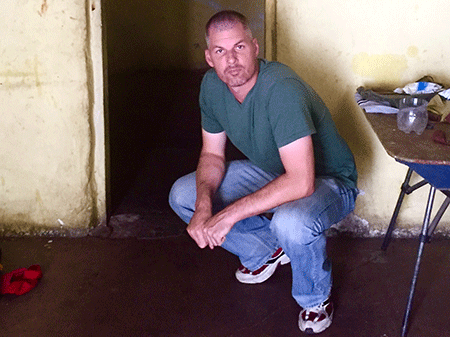
Criminal Alien-Nations: Deportation and Navigating Northern Mexico
by Tobin Hansen, PhD candidate, Department of Anthropology
Snoop and I hang out on the stairs, talking, under the portico of a dental office with black lettering in the window: “English Spoken.” People come and go on this bustling street two blocks south of the U.S.-Mexico border fence. Snoop explains, with characteristically artful English, how men deported from the United States negotiate northern Mexico border cities: “There’s a lot of places you can’t go, you know, if you’re a deportee. You gotta’ watch out for the cops and the Mafia [organized crime]. It’s different for white people [border-crossing U.S. tourists]. They get the juice card. They can go anywhere they want. It’s the super juice card [laughing]—it’s the platinum card!” Snoop indicates the direct influence of constructed social difference markers—such as race, nationality, and socioeconomic status—on individual prerogative for moving through the world. His comments also suggest the complexity with which places and their embedded social dynamics shape everyday interactions.
With generous support from CLLAS and others, I have conducted ten months of ethnographic research in Nogales, Sonora, with some of the tens of thousands of “criminal alien” men deported to northern Mexico each year of the last decade. To gain a better understanding of deportees’ perceptions of social belonging, I asked a fundamental question: How do deportees navigate social and spatial geographies in their receiving communities?
This inquiry becomes particularly critical for deportees that embody non-local, outsider identities. For example, the segment of “criminal alien” deportees I work with have few or no memories of Mexico and are seen as criminal, pocho (“Americanized”) outsiders. They came to the United States with family as child migrants decades ago. As adults, they became ensnared in U.S. crime control regimes, were incarcerated in U.S. prisons, designated “criminal aliens,” and deported back to Mexico. For example, Snoop was brought to Los Angeles at six months old and had never been back to Mexico until he was deported at 48, in 2012. Like Snoop, several deportees have described the various vulnerabilities engendered by their precarious social positioning—family separation, difficulty securing shelter and daily sustenance, mental and physical distress, lack of job opportunities, and interpersonal violence at the hands of organized crime or corrupt police. These risks are implicated in the embodied experiences of deportees’ marginalization. Deportees’ susceptibilities in Nogales have become apparent over long hours with deported men as we walk—or avoid walking—around streets and neighborhoods and talk, in groups or one-on-one, at places where deportees wash cars, sell kitschy Mexican crafts, gather after a day of work at a bilingual call center, or hang out, as Snoop and I do on this bright spring day outside the dental office.
As we talk, Snoop exhibits his usual wit. But that doesn’t dampen his keen self-awareness. Despite the levity of our repartee, we both keep our eye out for police, who routinely extort Snoop for a few pesos, or, if he has nothing on him, book him into jail for 36 hours. Snoop combines wit with sharp observation as he outlines his perception of the social hierarchy in northern Mexico:
It’s the Mafia [organized crime] at the top. Then white people [border-crossing U.S. tourists]. Then rich people. Then the police maybe. Then the people that own businesses, your everyday José [laughing]. You know, the people that own businesses, that have like food carts and stuff… All I know is we’re [deported people] way at the bottom. We’re below the peasants. It’s the heathens, the peasants, then the deportees, way down here [laughing].

Analyzing both perceptions of social positioning and movement in space allows for a richer understanding of the consequences of deportation on deportees themselves. This approach draws from critical phenomenology and seeks to recognize the humanity in people’s subtle shifts in ways of being-in-the-world. It examines experiences and understandings of self in relation to others, and, crucially, connects coercive state practices—such as deportation—with their lived consequences. The grounded experiences of people like Snoop help tease out the inequalities embedded within broad social, economic, and political structures that lead to state expulsion and population displacement.
—Tobin Hansen is a doctoral candidate in cultural anthropology. He researches gender, care, gangs, the post-prison diaspora, and deportation in the U.S.-Mexico borderlands. This work has been funded by CLLAS, as well as the Wenner-Gren Foundation, a Social Science Research Council fellowship supported by the Andrew W. Mellon Foundation, the Center for the Study of Women in Society, Global Oregon, and the Center on Diversity and Community.
